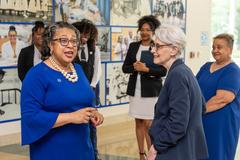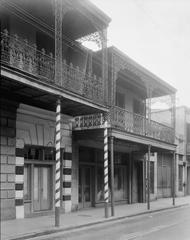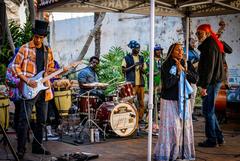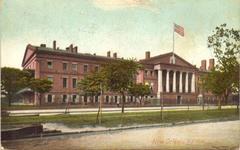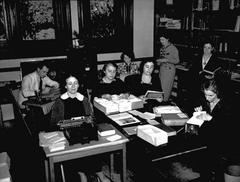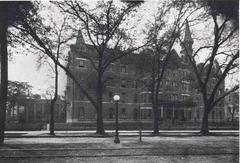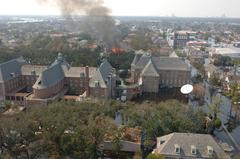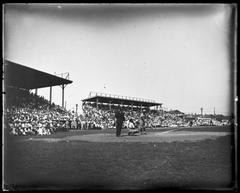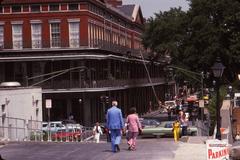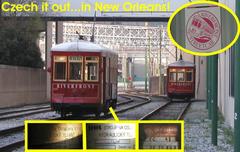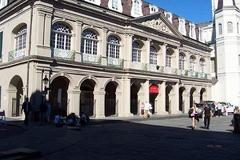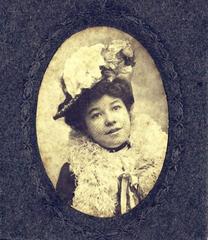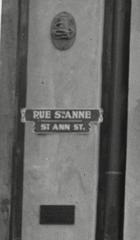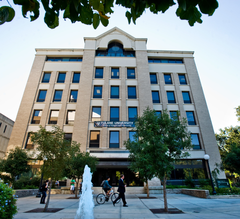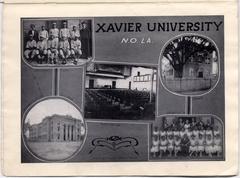
St. Augustine Church New Orleans: Visiting Hours, Tickets, and Historical Sites Guide
Date: 04/07/2025
Introduction
St. Augustine Catholic Church in New Orleans stands as a powerful symbol of resilience, faith, and cultural heritage. Established in 1841 in the Tremé neighborhood—the oldest African American community in the United States—St. Augustine is recognized as the nation’s oldest Black Catholic parish. Founded by free people of color during a period of deep racial segregation, the church’s history is intertwined with the African American and Creole experience, serving as a spiritual, social, and cultural anchor for nearly two centuries (BlackPast; St. Augustine Church History; The Catholic Travel Guide).
Architecturally, St. Augustine is a neoclassical gem designed by J. N. B. de Pouilly, bearing both European Catholic and local Creole influences in its stained glass and liturgical furnishings (Wikipedia; Searchable Museum). Today, it remains a vibrant hub for community, music, and social justice—hosting events like the renowned Jazz Mass and serving as a focal point for activism and cultural celebration (New Orleans Historical; NewOrleans.com).
This guide provides detailed visitor information—including hours, accessibility, tour options, and travel tips—alongside insights into the church’s historical, architectural, and cultural significance. Whether you are interested in history, architecture, or music, St. Augustine offers a uniquely immersive experience in the heart of New Orleans (St. Augustine Church Official Site; Lonely Planet).
Table of Contents
- Founding and Early Development
- Architectural Highlights
- Community and Cultural Impact
- Visiting Information
- Key Sites and Memorials
- Annual Events and Festivals
- Nearby Attractions
- Frequently Asked Questions (FAQ)
- Conclusion and Recommendations
- References
Founding and Early Development
Founded in 1841 by free people of color, St. Augustine Catholic Church was envisioned as a spiritual home that embodied equality within the Catholic tradition. The land, once part of the Claude Tremé plantation, was purchased by Black residents including Jeanne Marie Aliquot in 1834 (St. Augustine Church History). The church’s construction was a community effort, highlighted by the legendary “War of the Pews”—a contest where free Black parishioners bought pews for themselves and for enslaved individuals, ensuring the church became a rare, racially integrated place of worship in the pre-Civil War South (The Catholic Travel Guide).
Architectural Highlights
St. Augustine Church was designed by J. N. B. de Pouilly, the architect behind St. Louis Cathedral. The building exemplifies neoclassical style with a brick and stucco façade, tall arched windows, and a prominent steeple (Wikipedia). Inside, the basilica layout features original wooden pews, a semicircular apse, and stained-glass windows depicting saints with French names, reflecting the parish’s deep roots in French Catholic tradition (Searchable Museum; NCR Online).
The sanctuary contains notable 19th-century liturgical furnishings, and the church’s interior design narrates the multicultural heritage of its congregation.
Community and Cultural Impact
A Pillar of African American Heritage
Throughout its history, St. Augustine Church has served as a spiritual and cultural anchor for Black and Creole New Orleanians. By the mid-19th century, two-thirds of parishioners were free or enslaved people of color. The church was home to notable figures such as civil rights activist Homer Plessy, NAACP attorney A.P. Tureaud, jazz musician Sidney Bechet, and Mardi Gras Indian Chief Tootie Montana (BlackPast).
Cultural Hub and Social Justice Catalyst
St. Augustine has long championed social justice, serving as a platform for civil rights activism and community organization (St. Augustine Church Social Justice). Its Jazz Mass, hosted during the Satchmo Summer Festival, blends Catholic liturgy with local musical traditions. The church also participates in citywide events like the French Quarter Festival and Tremé Fall Fest, celebrating New Orleans’ musical and cultural heritage (The Catholic Travel Guide; NewOrleans.com).
Visiting Information
Hours and Mass Schedule
- General Visiting Hours: Monday to Saturday, 9:00 AM–5:00 PM; Sunday, 8:00 AM–6:00 PM (may vary for holidays or special events—verify on the official website)
- Sunday Mass: 10:00 AM
- Wednesday Mass: 5:00 PM
- Community Rosary: Wednesdays at 4:30 PM
Special liturgies and devotions occur throughout the year, such as the MLK Weekend Devotion and the annual Satchmo Summer Festival Jazz Mass (NOLA Catholic).
Admission and Tickets
- Admission: Free; donations are encouraged to support restoration and community programs.
- Guided Tours: Available by appointment. Contact the parish office at 504-525-5934 or through the official site.
Accessibility
- The church is wheelchair accessible, featuring ramps and accessible restrooms, though some historic areas may have uneven flooring.
- Assistance is available upon request.
Travel Tips
- Parking nearby is limited; public transit or rideshare is recommended.
- Modest attire is encouraged, especially for religious services.
- Discreet photography is allowed; please be respectful during Mass or events.
- Check for weather updates and festival schedules (Go Far Grow Close).
Key Sites and Memorials
Tomb of the Unknown Slave
Outside the church stands the Tomb of the Unknown Slave—a cross made of chains—honoring enslaved individuals whose lives were integral to the church and community (St. Augustine Church; Tomb of the Unknown Slave). Regular devotions are held here, fostering remembrance and reflection.
Annual Events and Festivals
- Tremé Fall Festival: October, featuring live music, local food, arts, and a traditional Second Line parade (Tremé Fest).
- Satchmo Summer Festival Jazz Mass: First Sunday in August, followed by a Second Line Parade.
- Other Notable Events: French Quarter Festival, Mardi Gras celebrations, and community outreach activities.
Nearby Attractions
Within walking distance from St. Augustine Church:
- Backstreet Cultural Museum: Showcasing Mardi Gras Indian culture and New Orleans traditions.
- Louis Armstrong Park and Congo Square: Landmarks in jazz and African American history.
- New Orleans African American Museum: Celebrating the city’s Black heritage (Lonely Planet).
Frequently Asked Questions (FAQ)
Q: What are St. Augustine Church’s visiting hours?
A: Monday to Saturday, 9:00 AM–5:00 PM; Sunday, 8:00 AM–6:00 PM. Always check the official website for updates.
Q: Is there an admission fee or are tickets required?
A: No admission fee; donations are welcomed.
Q: Are guided tours available?
A: Yes, by appointment. Contact the church directly to arrange a tour.
Q: Is the church wheelchair accessible?
A: Yes, with accessible restrooms and ramps. Some historic areas may have uneven flooring.
Q: Can I attend the Jazz Mass or other special events?
A: Yes, visitors are welcome. Check the schedule on the parish website for event dates and times.
Q: Can I take photographs inside the church?
A: Discreet photography is permitted; please be respectful during services.
Conclusion and Recommendations
St. Augustine Catholic Church in New Orleans is a living monument to faith, resilience, and the enduring legacy of the African American and Creole communities. Its neoclassical architecture, evocative stained glass, and sacred art invite visitors to contemplate centuries of devotion and struggle. Annual events like the Jazz Mass and the Tremé Fall Festival, alongside the Tomb of the Unknown Slave memorial, ground the church’s mission in both remembrance and celebration.
Despite challenges from natural disasters and the passage of time, St. Augustine continues to thrive thanks to dedicated preservation efforts and community support. Its doors are open to all—offering free admission, guided tours upon request, and accommodations for diverse needs.
To plan your visit, always check the official parish website for the latest information on hours and events. For a deeper experience, explore related New Orleans historical sites, and consider supporting preservation initiatives through donations or festival attendance.
Download the Audiala app for curated insights and real-time updates on New Orleans cultural landmarks, and follow St. Augustine Church on social media for ongoing news and events. Embrace the opportunity to discover where faith, history, and the vibrant spirit of New Orleans converge.
References
- BlackPast
- St. Augustine Church History
- The Catholic Travel Guide
- Wikipedia
- New Orleans Historical
- Verite News
- St. Augustine Church Official Site
- New Orleans Historical Sites
- New Orleans Music
- NewOrleans.com
- Tomb of the Unknown Slave
- Searchable Museum
- NCR Online
- New Orleans Tourism
- Lonely Planet
- Black Catholic Messenger
- Tremé Fest
- NOLA Catholic
- Go Far Grow Close
- Audiala App









